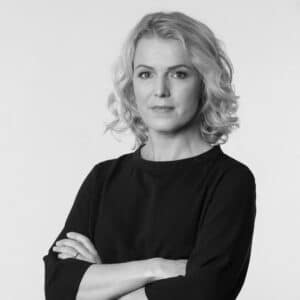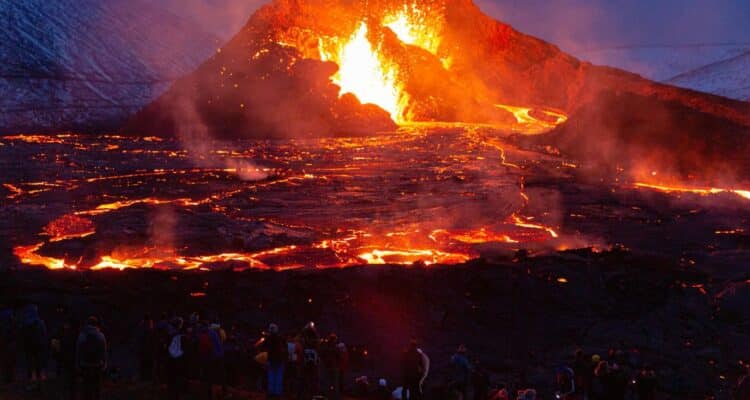Sigríður Hagalín Björnsdóttir’s The Fires explores the metaphors of heat and fire through the gorgeous and dangerous entanglement of Anna’s volcano research and her fiery affair with a bohemian photographer. She’s become as unpredictable to herself as the series of earthquakes threatening Reykjavik. She wants to give in to love, protect her family, and save her country, but it may not be possible to do all three. We’re so thrilled Sigríður Hagalín Björnsdóttir shared some insights on her stunning novel.
Amy Wilhelm: How did you feel/react when you were approached for an English translation edition of The Fires?
Sigríður Hagalín Björnsdóttir: I was thrilled, of course! My previous books had been translated into other languages, but none that I could read myself. Good translators are the most important people in the world. Without them, we would be locked away in our small, separate worlds and would have missed some of the most beautiful, enlightening, and mind-blowing literature in the world. They will never be replaced by machines or algorithms because they don‘t only mediate the words but the thoughts and culture between different worlds.
I write in Icelandic, a language spoken by some 350,000 people, and without wonderful translators like Larissa Kyzer, my novels would be locked up in an airless room.
AW: What’s one thing you want your new English-speaking audience to know about the book?
SHB: The Fires is not a typical disaster novel. It’s a book about a volcanologist, Anna, who has to deal with a series of volcanic eruptions just outside Reykjavik, the capital of Iceland. She’s a top-notch scientist and part of the national security council but also dedicated to her family. She has to face some difficult choices handling the response to the eruptions, at the same time as she suffers the calamity of falling in love with a stranger and upsetting her comfortable marriage and family life.
It’s a story of love as a natural disaster.
AW: What was the inspiration for the book?
SHB: Before I began writing novels, I worked for many years as a television news journalist in Iceland – and I still do. Iceland is a very geologically active country, and an important part of my job as a journalist is to cover eruptions, which happen about four times a decade on average. And I’m fascinated by eruptions in all their dramatic, creative, destructive glory. Still, it didn’t occur to me to write a novel about them until four years ago. What sparked the idea was a magazine article – I think it was National Geographic – about the magnetic North Pole, which has been on the move for the last few decades. They interviewed a geologist, who said: “As everybody knows, the magnetic North Pole is a very sensitive place.” And then I just knew I had hit something. I had found my main character, this volcanologist who’s so immersed in her work that she thinks about Earth as a living, feeling organism, and cannot understand that other people don’t think the same. Also, it gave me an opportunity to write about something I knew and loved in my other line of work.
AW: Were your characters inspired by people in your life?
SHB: No, not really. Except that, in some way, they’re all made out of little pieces of me.
AW: The Fagradalsfjall volcano recently erupted a few months ago. Were you surprised with the eerily timed eruption matching your American debut?
SHB: Yes – and no. Four months after the book was first published in Iceland, the first Fagradalsfjall eruption began only a few kilometers and a few days away from the eruption in the novel. It earned me a reputation as a seeress – quite undeservedly, I have no psychic talents whatsoever.
But books sometimes know more than the people who write them.
AW: Have you ever seen a volcanic eruption up close?
SHB: Yes, many times, and they’re beautiful! Terrifying, dramatic, but also strangely calm and natural. It‘s a little like attending childbirth – it‘s the most natural, common thing in the world, but also a miracle that will bring you to tears.
AW: How much research did you have to do for the book?
SHB: It took a lot of research. I have some rudimentary knowledge of volcanology, having covered many eruptions, but I’m no expert, of course. The devil is in the detail, as they say, and I wanted to make sure that every disaster scene I wrote was realistic and could actually happen. I had to read through many books and scientific journals, and some of the most distinguished volcanologists in Iceland helped me, telling me stories, reading my drafts, and correcting my errors.
AW: What was the most difficult part of writing the story?
SHB: Sex is always difficult to write. There is nothing like a bad erotic description to damage an otherwise good book. I think you should never use sex in a novel unless absolutely necessary. Not out of prudishness, but aesthetics – an unnecessary sex description will always feel clumsy, embarrassing, like a bump on the road.
If it’s good, and in the right place, it will be transcendental and move the reader – to tears, desire, laughter, a deeper understanding. It works like cayenne pepper in food.
AW: What is your favorite part of the story?
SHB: I love the poetry. It’s not mine, I quote many poets who have written about volcanic eruptions, and I had a great time searching for lines to quote. My favourite character is Örn, Anna’s father, who’s also a volcanologist and raised her on his own.
AW: What can readers expect next from you?
SHB: My latest book, the Fortune of this World, is a historical novel set in the 15th Century when Iceland was torn between English merchants, the Danish king, and local gentry. It’s the story of Ólöf Loftsdóttir, the most powerful woman in Icelandic history, who effectively ruled the country, but it’s also set in the present, where a harrassed history professor is thrown into exile in the wake of the #metoo-movement. I’ve just started working on the sequel.
 Sigríður Hagalín Björnsdóttir studied history in Reykjavík and Salamanca and journalism at Columbia University in New York and previously worked in Copenhagen before moving back to Reykjavík, where she lives with her husband, children, and stepchildren. Her bestselling debut, Island (2016), was nominated for the Icelandic Women’s Literature Prize in 2017. Her second novel, The Holy Word, came out in 2018. The Fires was a bestseller and viral hit in Iceland when it was published in 2020, and is the first of her novels to be published in English (in February 2023 by Amazon Crossing). When she isn’t writing, Sigríður works as a journalist and television news anchor at the Icelandic National Broadcasting Service.
Sigríður Hagalín Björnsdóttir studied history in Reykjavík and Salamanca and journalism at Columbia University in New York and previously worked in Copenhagen before moving back to Reykjavík, where she lives with her husband, children, and stepchildren. Her bestselling debut, Island (2016), was nominated for the Icelandic Women’s Literature Prize in 2017. Her second novel, The Holy Word, came out in 2018. The Fires was a bestseller and viral hit in Iceland when it was published in 2020, and is the first of her novels to be published in English (in February 2023 by Amazon Crossing). When she isn’t writing, Sigríður works as a journalist and television news anchor at the Icelandic National Broadcasting Service.



I very delighted to find this internet site on bing, just what I was searching for as well saved to fav
tiktok follower kaufen paypal germany tiktok follower kaufen
maslak escort